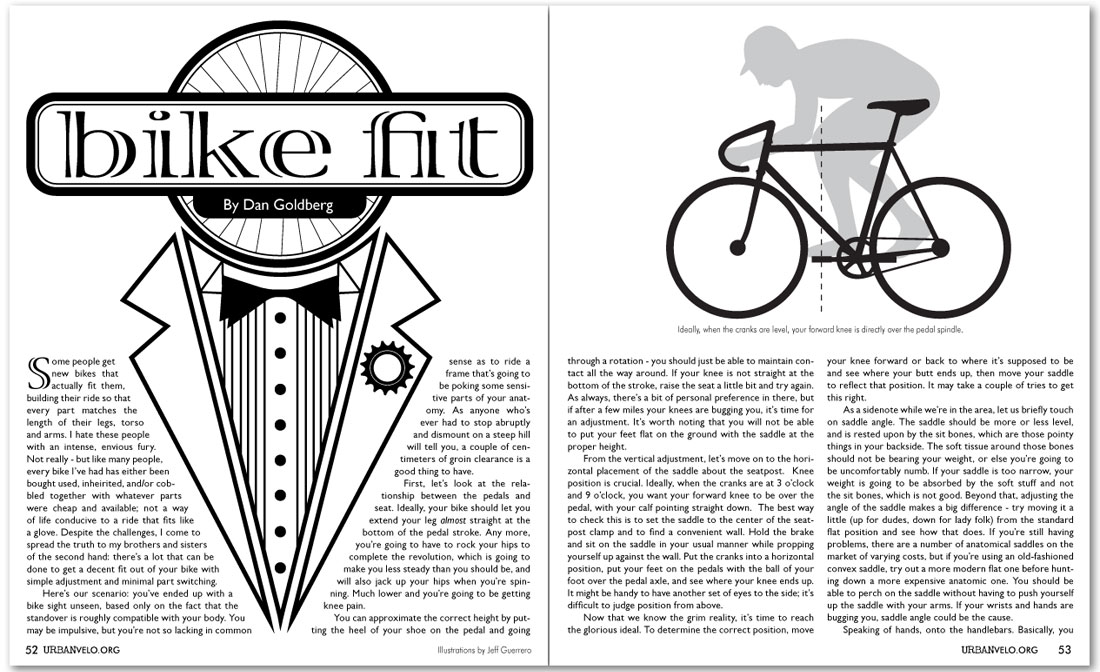| Bike Fit
By Dan Goldberg
Some people get new bikes that actually fit them, building their ride so that every part matches the length of their legs, torso and arms. I hate these people with an intense, envious fury. Not really - but like many people, every bike I’ve had has either been bought used, inheirited, and/or cobbled together with whatever parts were cheap and available; not a way of life conducive to a ride that fits like a glove. Despite the challenges, I come to spread the truth to my brothers and sisters of the second hand: there’s a lot that can be done to get a decent fit out of your bike with simple adjustment and minimal part switching.
Here’s our scenario: you’ve ended up with a bike sight unseen, based only on the fact that the standover is roughly compatible with your body. You may be impulsive, but you’re not so lacking in common sense as to ride a frame that’s going to be poking some sensitive parts of your anatomy. As anyone who’s ever had to stop abruptly and dismount on a steep hill will tell you, a couple of centimeters of groin clearance is a good thing to have.
First, let’s look at the relationship between the pedals and seat. Ideally, your bike should let you extend your leg almost straight at the bottom of the pedal stroke. Any more, you’re going to have to rock your hips to complete the revolution, which is going to make you less steady than you should be, and will also jack up your hips when you’re spinning. Much lower and you’re going to be getting knee pain.
You can approximate the correct height by putting the heel of your shoe on the pedal and going through a rotation - you should just be able to maintain contact all the way around. If your knee is not straight at the bottom of the stroke, raise the seat a little bit and try again. As always, there’s a bit of personal preference in there, but if after a few miles your knees are bugging you, it’s time for an adjustment. It’s worth noting that you will not be able to put your feet flat on the ground with the saddle at the proper height.
From the vertical adjustment, let’s move on to the horizontal placement of the saddle about the seatpost. Knee position is crucial. Ideally, when the cranks are at 3 o’clock and 9 o’clock, you want your forward knee to be over the pedal, with your calf pointing straight down. The best way to check this is to set the saddle to the center of the seatpost clamp and to find a convenient wall. Hold the brake and sit on the saddle in your usual manner while propping yourself up against the wall. Put the cranks into a horizontal position, put your feet on the pedals with the ball of your foot over the pedal axle, and see where your knee ends up. It might be handy to have another set of eyes to the side; it’s difficult to judge position from above.
Now that we know the grim reality, it’s time to reach the glorious ideal. To determine the correct position, move your knee forward or back to where it’s supposed to be and see where your butt ends up, then move your saddle to reflect that position. It may take a couple of tries to get this right.
As a sidenote while we’re in the area, let us briefly touch on saddle angle. The saddle should be more or less level, and is rested upon by the sit bones, which are those pointy things in your backside. The soft tissue around those bones should not be bearing your weight, or else you’re going to be uncomfortably numb. If your saddle is too narrow, your weight is going to be absorbed by the soft stuff and not the sit bones, which is not good. Beyond that, adjusting the angle of the saddle makes a big difference - try moving it a little (up for dudes, down for lady folk) from the standard flat position and see how that does. If you’re still having problems, there are a number of anatomical saddles on the market of varying costs, but if you’re using an old-fashioned convex saddle, try out a more modern flat one before hunting down a more expensive anatomic one. You should be able to perch on the saddle without having to push yourself up the saddle with your arms. If your wrists and hands are bugging you, saddle angle could be the cause.
Speaking of hands, onto the handlebars. Basically, you (continued)
|
|
|
|
|
|

